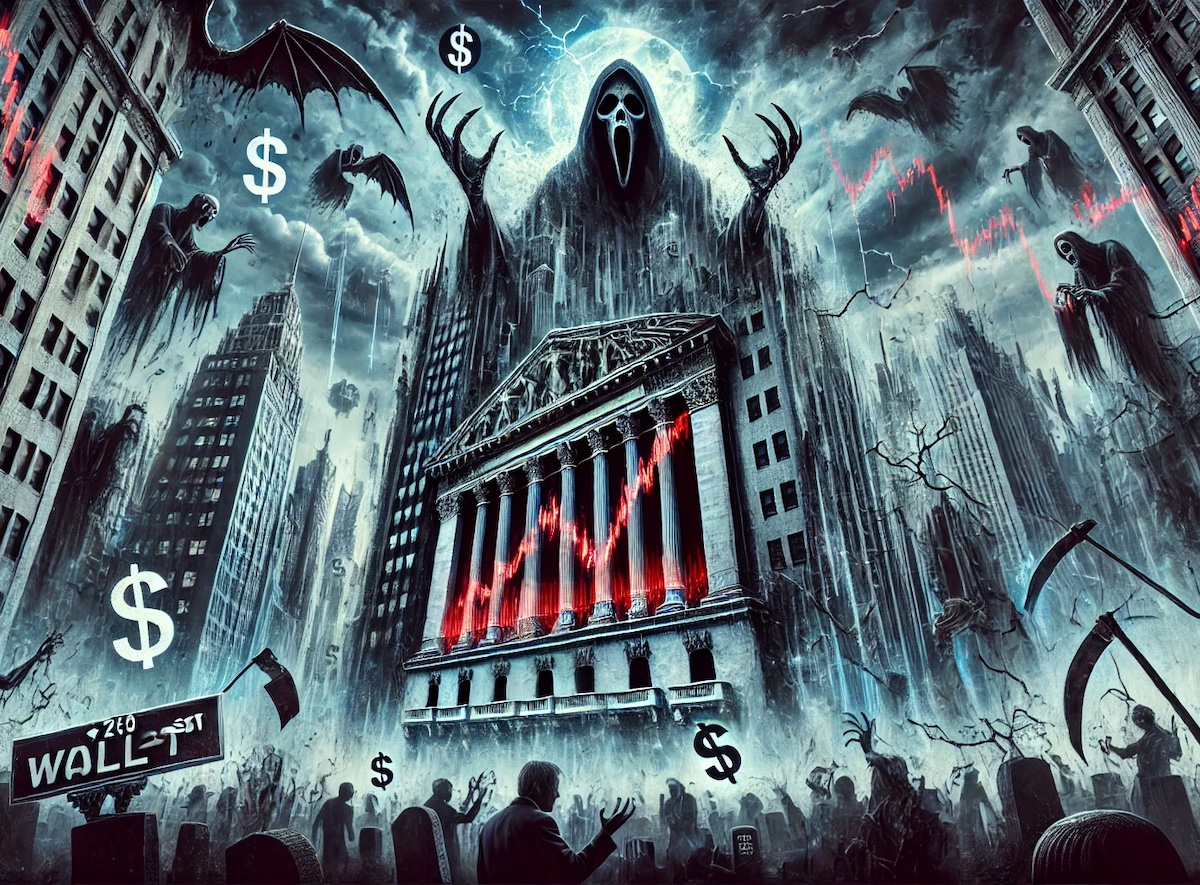The Halloween Stock Market Crash of 2024: A Nightmare Unfolds on Wall Street
On Halloween, the stock market delivered a scare. In a single trading day, the S&P 500 and Nasdaq suffered their worst declines in over a month, with the tech-heavy Nasdaq sliding an unnerving 2.76% to close at 18,095.15. Meanwhile, the S&P 500 tumbled 1.86%, finishing at 5,705.45, marking a chilling one-day drop that sent shockwaves through Wall Street. The Dow Jones, though not as heavily impacted, still fell by 378 points, or 0.9%, casting a pall over what had already been a turbulent October. | AUDIO | VIDEO
The crash was fueled by ominous quarterly reports from major tech giants, as investors watched Microsoft shares tumble 6% after a revenue guidance miss. Meta Platforms, too, disappointed with stagnant user growth and a warning of substantial capital expenditure increases in 2025. For companies that had thrived on the booming optimism surrounding artificial intelligence, the dip felt like a hard awakening. According to Ross Mayfield, an investment strategist at Baird Private Wealth Management, “We’re getting to the point where AI enthusiasm and potential is not enough.” His words echoed across the trading floors as tech companies that had once promised exponential growth struggled to deliver results that matched their sky-high valuations.
Adding to the tension was Thursday’s personal consumption expenditures (PCE) report, showing inflation inching closer to the Federal Reserve’s 2% target—a haunting figure that looms over the Fed’s upcoming interest rate decision on November 7. This uncertainty, combined with looming U.S. Presidential elections, has turned Wall Street into a haunted house of volatility and anxiety, with traders awaiting each piece of economic data like a ghostly portent.
For October, the results were ghastly: the Dow recorded its first monthly loss since April, declining 1.3%, while the S&P 500 shed 1%, and the Nasdaq slid 0.5%. As the final trading day of the month came to a close, the Halloween stock market crash of 2024 cemented itself as a chilling reminder of the uncertainty and fragility still haunting the economy. As investors gear up for November, they face a nightmarish specter of more volatility and the unsettling question: are we on the brink of an even darker chapter?

The economy finds itself haunted by the specter of stagflation, a chilling combination of stagnation and inflation that conjures memories of past economic nightmares. This eerie phenomenon casts a shadow over growth, as rising costs burden businesses and consumers alike while economic output remains sluggish. Despite the Fed’s efforts to tame inflation with rate hikes, stubborn price increases continue to haunt household budgets, leaving real wages and consumer spending in the crypt of economic decay. As job growth slows and supply chain woes linger, the ghastly threat of stagflation seemingly reanimates, creating a chilling landscape where prosperity feels like a distant apparition. Economists warn that unless drastic measures are taken, this specter could haunt the second half of the decade, stifling both confidence and consumption as businesses and households grapple with an economy caught between two terrifying worlds.
Real Estate’s Halloween Horror: Agents Haunted by Ghostly Sales, Foreboding Prices
By Corey Chambers
In the spine-chilling landscape of today’s real estate market, real estate agents face an all-too-real nightmare. Picture this: a haunted house where deals vanish into thin air, prices creep upward, and prospects seem as rare as a ghost sighting on Halloween night. But this isn’t fiction; it’s real life, and real estate agents across the nation are feeling the chills.
September brought frightful news for agents everywhere, with home sales dropping to the lowest levels since 2010—a ghoulish reminder of the eerie, echoing recession of years past. Across the country, sales of existing homes fell by 1% compared to August, with a seasonally adjusted annualized rate of just 3.84 million units sold. To add to the horror, year-over-year sales have plummeted by 3.5%, and the declines seem to show no mercy, sparing only the West region.
Agents are no strangers to the thrill and adrenaline of closing deals, but right now, it’s the slowest-moving zombie crawl toward the closing table, as properties sit longer on the market, lingering like haunted relics. Homes are languishing for an average of 28 days—seven days longer than this time last year. For agents who depend on quick turnarounds, the wait is a hair-raising suspense.
Cash: The Dark Horse of the Market
Cash buyers have taken the stage, casting an ominous shadow over traditional buyers and especially first-time home seekers, who have dwindled to a record low of just 26% of September sales. Cash reigns supreme, now comprising a staggering 30% of deals. It seems the typical mortgage-toting buyer has morphed into something of a ghostly apparition, while those bearing briefcases of cash slip through the doors undeterred. In times past, cash buyers accounted for a much smaller fraction, about 20%, but now their impact looms large, forcing other buyers to the periphery.
Even investors, typically ready to pounce on distressed properties like spectral wolves, have pulled back, dropping from 19% of August’s transactions to 16% in September. For agents, this only amplifies the howls in the night, as every lost investor sends a chilling reminder of the unforgiving state of the market.
Inventory Rises—But So Do the Prices
Just when buyers and agents alike thought the skeletons were out of the closet, inventory crept up by 1.5% to a total of 1.39 million homes for sale, representing a 4.3-month supply at the current sluggish sales pace. This might sound like good news, but the increased availability has yet to relieve the spectral hand of rising prices. The median price for a home climbed to a gory $404,500—a 3% increase over last year. For 15 consecutive months, prices have continued their steady rise, feeding a market beast that seems insatiable.
A Haunting Tale of Mortgages and Mortality
The specter of mortgage rates still haunts buyers. Rates hovered around 7% in July, then dropped just below 6.5% in August—yet this slight dip hasn’t resurrected the buyer’s market agents had hoped for. Rates may be lower than a year ago, but many prospective buyers find themselves too spooked to dive in. And while distressed properties typically hint at bargains, they accounted for only 2% of September sales due to low delinquency rates, leaving little hope for price relief through foreclosures or short sales.
Is There a Silver Lining Beyond the Grave?
Despite the desolate landscape, there’s a flicker of light—or at least economist Lawrence Yun thinks so. Yun points out that factors often leading to higher home sales, like low mortgage rates and an influx of listings, are slowly beginning to manifest. But for now, agents remain trapped in a haunted house of fading commissions and shriveling bank accounts.
As Halloween dawns, agents find themselves not just donning costumes, but also putting on brave faces to confront the terrifying reality of today’s market. They wander the eerie halls of listings, hoping to catch a glimpse of that elusive buyer ready to make an offer. And until the ghosts of market rates, low inventory, and hauntingly high prices are put to rest, it seems agents must endure this tale of real estate horror—one haunting day at a time.
FIND OUT HOW MUCH YOUR HOME IS WORTH — FREE, ONLINE! Get a free list of recently sold homes in Los Angeles, Orange County or any area. Fill out the online form.

Copyright © This free information provided courtesy Entar.com with information provided by Corey Chambers, Broker DRE 01889449. We are not associated with the seller, homeowner’s association or developer. For more information, contact 888-240-2500 or visit WeSellCal.com Licensed in California. All information provided is deemed reliable but is not guaranteed and should be independently verified. Text and photos created or modified by artificial intelligence. Properties subject to prior sale or rental. This is not a solicitation if buyer or seller is already under contract with another broker.













